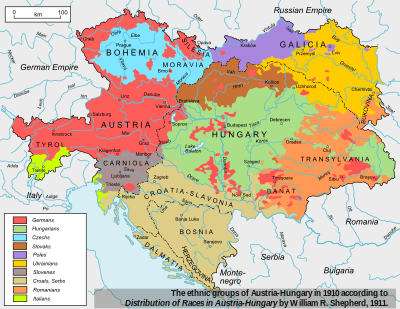Trialism in Austria-Hungary

In the history of the Austria-Hungary trialism refers to a movement, desire and drive to reorganize the bipartite Empire into tripartite one, creating a Croatian state equal in status to Austria and Hungary.[1] The movement originated in the 1880s in aristocratic and clerical circles of the Empire as a reaction to Hungarian nationalism[2] and must be contrasted to the revolutionary, secessionist Yugoslavism, as it worked within the Habsburg state apparatus with support from Croat politicians and Austrian officials (including the Archduke Franz Ferdinand.[1]) The hope of trialist Austrian imperialists was that Serbia might eventually join the great Croatia that was to be created, while putting pressure on the Hungarians and allowing Vienna to continue to dominate the Empire as a whole.[2]
In the early and mid-19th century the movement was Pan-Slavic and demanded that, in addition to the Austrian and Hungarian crowns, a third Slavic crown be established (North Slavs and the South Slavs separately), to allow the empire to resist claims from other Slavic countries and nations (Russia and Serbia.) With the collapse of the early panslavic (Czech-Slovak and Croatian-Slovene-Serb) movements, the new concept of trialism was strictly relegated to Croatia. After the Austro-Hungarian Compromise of 1867 and the Croatian-Hungarian Compromise of 1868 there was great dissatisfaction among the Croatian population that was divided between the two crowns of the empire (Croats in Istria and Dalmatia under the Austrian crown, Croats in Croatia and Slavonia under the Hungarian, and Bosnia-Herzegovina divided between them.) Strong pressure for the reorganization of the empire arose mainly from Croatia-Slavonia and Bosnia-Herzegovina, who since the 1848-49 defeat of the Hungarians had resented their association with them. There were many trialist propositions proposed but the common idea was that the monarchy would be composed of empire of Austria, kingdom of Hungary and kingdom of Croatia. In Croatia the most prominent advocates of the idea were Dr.Nikola Zvonimir Bjelovučić, author of the book Trialism and the Croatian state. Dr. Ivo Pilar, historian, politician and K.u.K. officer who advocated the idea of trialism in his book The South Slav Question, Dr. Aleksandar Horvat, leader of the pro-monarchy Pure Party of Rights and Croatian delegate at the signing of the trialist treaty in Vienna and Budapest 1918.[3] General Stjepan Sarkotić, Field marshal Svetozar Borojević, Ivo Prodan, archbishop Josip Štadler.
Habsburg family and trialism
Among the Habsburg family supporters of reorganizing the empire from a dualist to a trialist one included Archduke Leopold Salvator who served as an artillery officer in Zagreb 1894-1900, Crown Prince Rudolf who supported federalization of the monarchy, and Archduke Franz Ferdinand, the most prominent trialist supporter making him a threat to the Serbian liberation movement and leading to his assassination in Sarajevo. During his short reign Emperor and king Charles I (IV) supported the trialist idea only to be vetoed by the Hungarian government and Count Istvan Tisza. The count finally signed the trialist proclamation after heavy pressure from the king on 23 October 1918, one day after the king.[3]
See also
References
- ↑ 1.0 1.1 "Bosnia-Hercegovina". Eastern Europe. ABC-CLIO. p. 644.
- ↑ 2.0 2.1 Nevenko Bartulin (2012). "From independence to trialism: the Croatian Party of Right and the project for a liberal "Greater Croatia" within the Habsburg Empire, 1861–1914". In Matthew P. Fitzpatrick. Liberal Imperialism in Europe. Palgrave Macmillan. p. 130.
- ↑ 3.0 3.1 Budisavljević, Srđan, Stvaranje-Države-SHS, Creaton of the state of SHS, Zagreb, 1958, p. 132.-133.